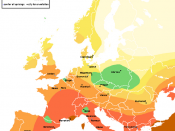Since the reign of Emperor Justinian in 542 A.D., man has one unwelcome organism along for the ride, Yersinia pestis. This is the bacterium more commonly know as the Black Death, the plague. Plague is divided into three biotypes, each associated with one of three major pandemics occurring in history. Each of these biotypes are then divided into three distinct types, classified by method of infection.
The most widely know is bubonic, an infection of plague that resides in the lymph nodes, causing them to swell. The Black Death of the 14th century was mainly of this type. Bubonic plague is commonly spread through fleas that have made a meal from an infected Rattus rattus.
The most dangerous type of plague is pneumonic. It can be spread through aerosol droplets released through coughs, sneezes, or through fluid contact. It may also become a secondary result of a case of untreated bubonic or septicemic plague.
Although not as common as the bubonic strain, it is more deadly. It has an untreated mortality rate on nearly 100%, as compared to 50% untreated mortality for bubonic plague. It attacks the respiratory track, furthering the cycle.
The third type of plague is septemic. It is spread by direct bodily fluid contact. It may also develop as a secondary result of untreated bubonic or pneumonic plague.
A LITTLE HISTORY As mentioned before, the most known incidence of bubonic plague was in 14th century Europe. In 1346 reports of a terrible pestilence in China, spreading through Mesopotamia and Asia Minor had reached Europe, but caused no concern until two years later. In January of 1348 the plague had reached Marseille in France and Tunis in Africa. By the end of the next year the plague had reached as far as Norway, Scotland, Prussia, Iceland, and...


